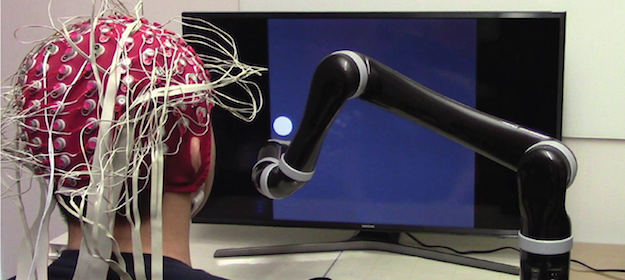
Researchers boost precision of robotic arm controlled without brain implants
By DE Staff
AutomationCarnegie Mellon team’s non-invasive robotic device shows promise for paralyzed patients.

This non-invasive brain-computer interface (BCI) created Carnegie Melon Robotic allows user to control the 2D continuous movement of a 7–degree of freedom robotic arm to track a randomly moving target on a computer screen. (Photo credit: Carnegie Melon University)
While such tasks have been accomplished before, they have typically involved brain-computer interfaces (BCIs) that used invasive brain implants. BCIs without brain implants are less complicated and dangerous to install, but typically produce sloppier control. The Carnegie Mellon team says the enhanced accuracy and responsiveness of their non-invasive system could hold great promise for paralyzed patients or those with severe motor limitations.
“There have been major advances in mind controlled robotic devices using brain implants. It’s excellent science,” says Bin He, Trustee Professor and Department Head of Biomedical Engineering at Carnegie Mellon University. “But non-invasive is the ultimate goal. Advances in neural decoding and the practical utility of non-invasive robotic arm control will have major implications on the eventual development of non-invasive neurorobotics.”
Previously robotic arms controlled by humans noninvasively had followed a moving cursor in jerky, discrete motions—as though the robotic arm was trying to “catch up” to the brain’s commands. Using novel sensing and machine learning techniques, Dr. He and his lab have been able to access signals deep within the brain to allow human subjects control a robotic arm so that it can now follow the cursor continuously.
In a paper published in Science Robotics, “Noninvasive neuroimaging enhances continuous neural tracking for robotic device control,” the team shows their unique approach enhanced BCI learning by nearly 60% for traditional center-out tasks and enhanced continuous tracking of a computer cursor by over 500%.
“Despite technical challenges using noninvasive signals, we are fully committed to bringing this safe and economic technology to people who can benefit from it,” says He. “This work represents an important step in noninvasive brain-computer interfaces, a technology which someday may become a pervasive assistive technology aiding everyone, like smartphones.”
www.cmu.edu
